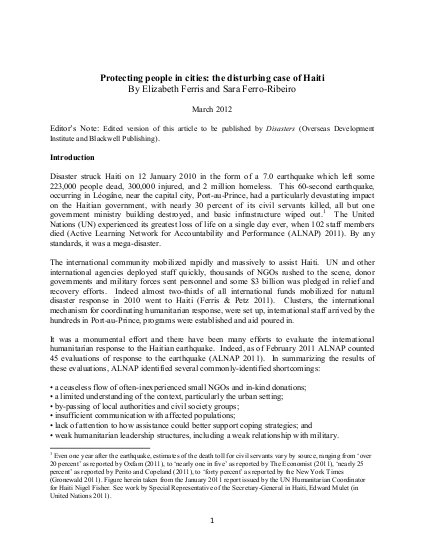
Disaster struck Haiti on 12 January 2010 in the form of a 7.0 earthquake which left some 223,000 people dead, 300,000 injured, and 2 million homeless. This 60-second earthquake, occurring in Léogâne, near the capital city, Port-au-Prince, had a particularly devastating impact on the Haitian government, with nearly 30 percent of its civil servants killed, all but one government ministry building destroyed, and basic infrastructure wiped out.1 The United Nations (UN) experienced its greatest loss of life on a single day ever, when 102 staff members died (Active Learning Network for Accountability and Performance (ALNAP) 2011). By any standards, it was a mega-disaster. The international community mobilized rapidly and massively to assist Haiti. UN and other international agencies deployed staff quickly, thousands of NGOs rushed to the scene, donor governments and military forces sent personnel and some $3 billion was pledged in relief and recovery efforts. Indeed almost two-thirds of all international funds mobilized for natural disaster response in 2010 went to Haiti (Ferris & Petz 2011). Clusters, the international mechanism for coordinating humanitarian response, were set up, international staff arrived by the hundreds in Port-au-Prince, programs were established and aid poured in. It was a monumental effort and there have been many efforts to evaluate the international humanitarian response to the Haitian earthquake. Indeed, as of February 2011 ALNAP counted 45 evaluations of response to the earthquake (ALNAP 2011). In summarizing the results of these evaluations, ALNAP identified several commonly-identified shortcomings: • a ceaseless flow of often-inexperienced small NGOs and in-kind donations; • a limited understanding of the context, particularly the urban setting; • by-passing of local authorities and civil society groups; • insufficient communication with affected populations; • lack of attention to how assistance could better support coping strategies; and • weak humanitarian leadership structures, including a weak relationship with military.
Published version of this document avilable for payment at: onlinelibrary.wiley.com/doi/10.1111/j.1467-7717.2012.01285.x/abstract
Links
Resource collections
- Earthquakes
- Learning from crises
- Topics
- UN Habitat - Urban Response Collection
- Urban Response - Urban Crisis Preparedness and Risk Reduction
- Urban Response Collection - Community Engagement and Social Cohesion
- Urban Response Collection - Economic Recovery
- Urban Response Collection - Environment and Climate Change
- Urban Response Collection - Housing, Land and Property
- Urban Response Collection - Urban Crisis Response, Recovery and Reconstruction
- Urban Response Collection - Urban Resilience
